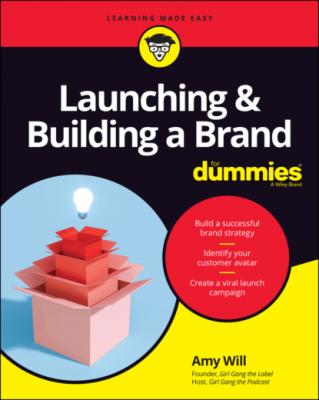Launching & Building a Brand For Dummies. Amy Will
Читать онлайн.| Название | Launching & Building a Brand For Dummies |
|---|---|
| Автор произведения | Amy Will |
| Жанр | Малый бизнес |
| Серия | |
| Издательство | Малый бизнес |
| Год выпуска | 0 |
| isbn | 9781119748052 |
Auditing and scaling your brand to increase its reach while expanding brand awareness
Building on customer loyalty and longevity to transform customers into brand advocates
Protecting your brand from competitors and anyone who may try to steal your intellectual property
Chapter 2
Creating and Financing Your Brand
IN THIS CHAPTER
Branding assumes that you have something to brand — a business, a product, a service, or even yourself. You need something you can stick a label or hang a sign on. If you already have that something clear in your mind, you can safely skip this chapter. If your vision is still a little fuzzy around the edges, or if you could use some guidance on coming up with an idea or getting your idea off the ground, you’ve come to the right place.
In this chapter, I introduce you to the various entities you can brand, and I highlight some differences in the branding process for each type. I show you how to find or choose a niche that improves your chances of success. I explain how to register your business/brand and choose the right legal structure for it. Last but not least, I reveal a few ways to get other people to help finance what may be a risky venture.
Deciding What You’re Going to Brand
You can create a brand for just about anything — products and services, businesses and corporations, performers and groups (think Cirque du Soleil), celebrities and influencers, government entities (including nations) and nongovernment organizations (NGOs), not-for-profit organizations, even places (I ♥ NY, for example). The four most commonly branded things are businesses, products, services, and individuals (personal branding).
Sometimes, the lines dividing these different brand types get a little blurry. When you are the business, for example, do you create a business brand or a personal brand? In this section, I introduce you to the four most common brand types so you can figure out what you’re branding and how that decision will affect your approach to branding.
Business or corporate brand
A business or corporate brand establishes and communicates an organization’s identity to all stakeholders, internal and external, including customers, investors, executives, managers, and staff. Corporate branding involves ensuring alignment of everything that goes into defining the organization’s identity, including the following:
Mission statement: The organization’s overall purpose.
Vision statement: How the organization plans to develop over time.
Values: The beliefs, philosophies, and principles that guide the organization’s decisions and behaviors.
Core competencies: The sets of resources and skills that enable an organization to deliver something special to the marketplace.
Value proposition: What the company delivers to the market that drives consumer demand for it.
Workplace culture: The way people within the organization generally think, behave, and interact. In a hierarchy, employees generally do what they’re told by their superiors, whereas in a more collaborative culture, everyone shares in decision-making and workplace management.
Business strategy: The way an organization chooses to achieve its goals and remain competitive.
Business activities: Daily operations, including marketing, sales, financing, customer service, and supply-chain management.
Affiliations: Partnerships, associations, and relationships with other businesses and with consumers. An organization’s identity is defined by the company it keeps.
Brand story: The narrative that relates the facts about a brand in a way that connects emotionally with people. (See Chapter 8 for details on how to compose a brand story.)
Brand style: Guidelines (see Chapter 6) that establish the brand’s look and feel.
Note that corporate branding isn’t covered in detail in this book, although some aspects of product, service, and personal branding (which are covered in this book) may apply to corporate branding as well.
Product brand
A product brand is a set of unique qualities — including design, packaging, and advertising — that makes a consumer good easily recognizable and special in the minds of consumers. Product branding entails the following activities:
Designing a recognizable and appealing logo (see Chapter 6)
Coming up with a clever, catchy brand name (see Chapter 3)
Establishing branding guidelines to ensure that all marketing has a consistent look and feel, and adjusting the guidelines to keep up with the times (see Chapter 6)
Researching the market to better understand customers and competing products (see Chapter 3)
Tailoring the message to appeal to different consumer demographics (see Chapter 8)
Differentiating your product from competing products (see “Identifying or Creating a Niche Market” later in this chapter)
Marketing/advertising
